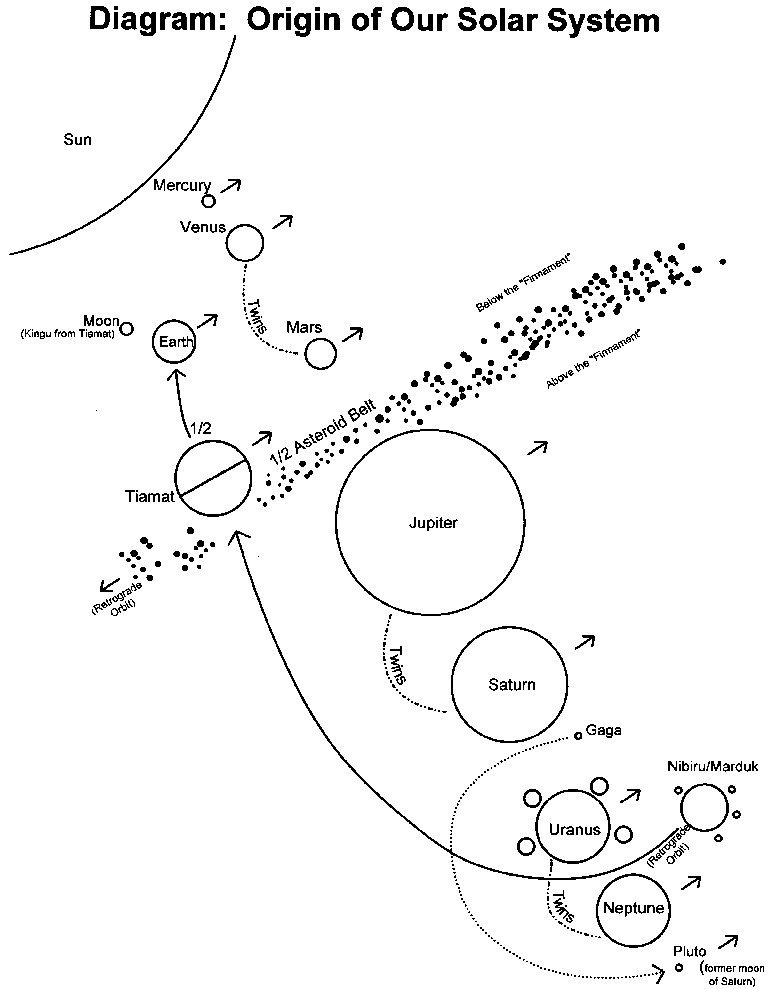
THE ORIGIN OF OUR SOLAR SYSTEM -
Patrick H. Bellringer
1. The first members of our Apsu Solar System were our Sun, Apsu, and planets Mercury and Tiamat (Ti. Amat). Tiamat "the water monster" was also called Gaia, meaning the cleaved one or Tiamat/Gaia.
2. Our solar system gradually expanded by the "birth" of three planetary pairs:
a) Venus and Mars --- placed between Mercury and Tiamat.
b) Jupiter and Saturn --- placed beyond Tiamat.
c) Uranus and Neptune --- placed farther out.
3. An invading planet from outer space, Nibiru (Sumerian) or Marduk (Babylonian), was drawn to our solar system and attracted to the outer planet, Neptune.
4. Nibiru/Marduk moved in a retrograde (clockwise) orbit which was counter to the other planets and had four satellites or moons.
5. Nibiru/Marduk passed in its orbit between Neptune and the next inner planet, Uranus.
6. As Nibiru/Marduk passed near Neptune, gravitational and magnetic forces caused "Marduk's side to bulge out. This side was pulled away and became Neptune's new moon, Triton, which now has also a retrograde (clockwise) orbit.
7. Consequently, Marduk collided with Uranus, tilting Uranus on its axis and creating Uranus' four moons. In the process Marduk gained three more moons for a total of seven.
8. Marduk was pulled toward the extremely large planets of Saturn and Jupiter and changed her orbital pathway forever.
9. As Marduk passed Saturn, Saturn's moon, Gaga, was pulled away in the direction of Mars and Venus and caused Gaga to have a "strange" elliptical orbit. Gaga eventually became the planet, Pluto.
10. Marduk's orbit was further altered by the pull of Jupiter, placing Marduk on a collision course with Tiamat.
11. Tiamat was a very unstable planet encircled by eleven satellites (moons), the largest of these was Kingu, a very large satellite.
12. Marduk did not collide with Tiamat, but Marduk's seven satellites smashed into Tiamat and her eleven satellites headed by Tiamat's largest satellite, Kingu.
13. Tiamat was split into two halves. The half toward the sun split off and became Gaia or Planet Earth Shan, and Kingu, Tiamat's principal satellite became Earth Shan�s moon.
14. The other half of Tiamat was smashed into bits and pieces. Through magnetic and gravitational forces these pieces were formed into the Asteroid Belt.
15. The Asteroid Belt with its comets continued moving in a retrograde orbit, as did Marduk. The Asteroid Belt has remained in the approximate place in the solar system as the former planet, Tiamat.
16. The Asteroid Belt is also known as the "firmament" or belt of frozen waters. Below the "Firmament" or toward the Sun are located four planets--Mars, Earth, Venus, and Mercury. Above the "Firmament" are located six planets--Jupiter, Saturn, Uranus, Neptune, Pluto, and the twelfth planet, Marduk.
17. Nibiru/Marduk was forced into an extreme elliptical orbit of some 3600 years, and is known today as the twelfth planet in our Apsu Solar System. This twelfth planet, Nibiru/Marduk, in its retrograde solar orbit is again approaching Earth Shan.

Reference: Phoenix Journal #50, entitled Through Darkness into Light.
--The Phoenix Journal/Contact Newspaper Archive site is at--
http://www.fourwinds10.com
--The Bellringer Writings are at--
http://www.fourwinds10.com
